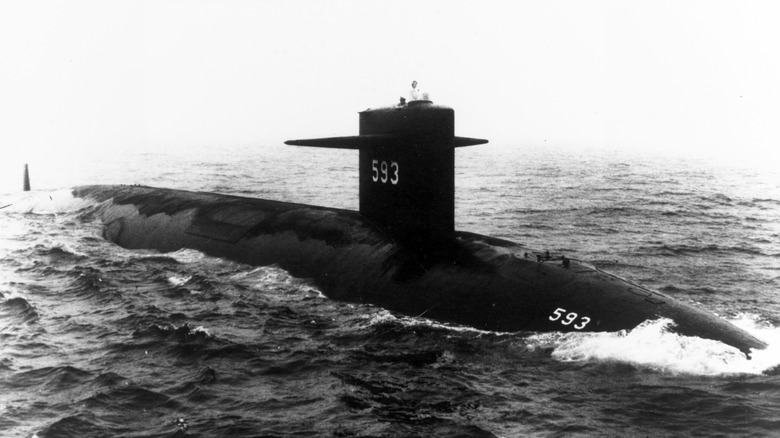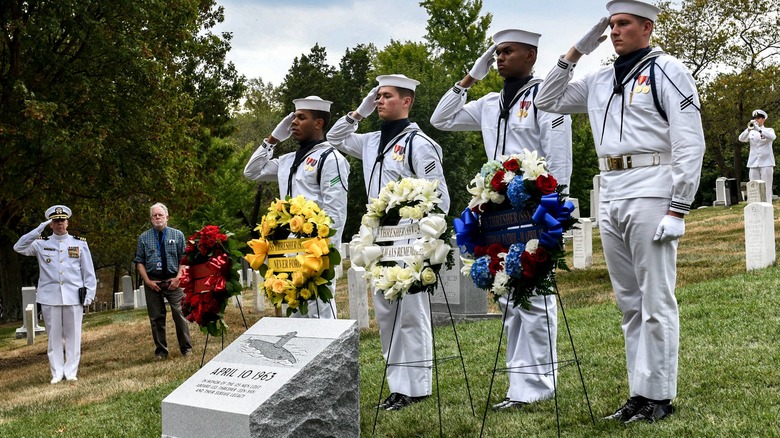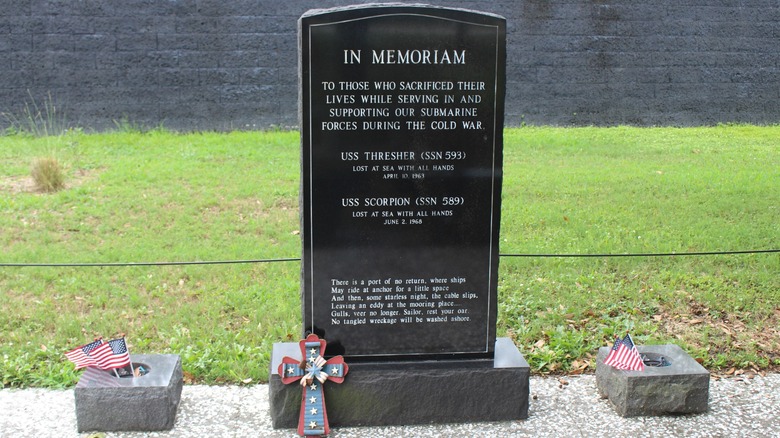Yes, The US Has Lost Not One, But Two Nuclear Submarines - Here's What Happened
Nuclear submarines are some of the most impressive and technologically advanced warships of all time, and the United States Navy has a boatload of them. In fact, every submarine operated by the U.S. Navy is nuclear powered, and they are some of the most important strategic assets in the fleet. That's true of the Virginia-class subs as well as the older Ohio-class variety. Still, despite the heavy protection and efforts made to ensure they're operated safely, the unforeseen can rear its ugly head.
This happened, not once, but twice, when two nuclear submarines were lost: the USS Thresher (SSN-593) and the USS Scorpion (SS-589). The loss of a nuclear submarine is catastrophic for a number of reasons, most notably the loss of life. The submarines had sizable crews, and none survived their destruction. In addition to the lives lost, nuclear submarines are expensive and vital pieces of equipment, so losing both during the height of the Cold War between the U.S. and the Soviet Union was devastating.
Those losses notwithstanding, nuclear submarines are powered by nuclear reactors, so there's the potential for environmental damage that can occur when they're exposed to seawater. The impacts can be widespread, but fortunately, neither accident resulted in dangerous impacts on marine ecosystems. Regardless, while there has been plenty of coverage about the two lost U.S. nuclear submarines, they remain largely unknown to the public these days. Here's what happened to the USS Thresher and USS Scorpion, may their losses never be repeated or forgotten.
The USS Thresher was lost in 1963 during deep-diving tests
The USS Thresher (SSN-593) was the lead boat in its class, first launched in July 1960, and commissioned in August the following year. It conducted sea trials in the Atlantic Ocean and Caribbean Sea between 1961 and 1962. In 1963, it was ready for deep-diving tests. The Thresher was built to dive to a maximum operational depth of 1,300 feet, which was a significant improvement over older models.
It was lost with all hands on April 10, 1963, around 220 miles East of Cape Cod, Massachusetts. The accident occurred one day after it put to sea for trials with 11 officers and 96 enlisted sailors onboard. There were also several civilians for a total of 129 personnel. The boat radioed to the USS Skylark (ASR-20), which accompanied the Thresher on its trials at 9:13 am, that the boat was "experiencing minor difficulties." The crew also communicated that they were pointing up and were trying to blow their ballast tanks, followed by "Will keep you informed."
A few minutes later, the Thresher reported via a garbled transmission that they were at their test depth, followed by coordinates. At around 9:18 am, the Skylark detected a low-frequency, high-energy noise that could only be caused by the Thresher imploding. Investigations followed to try to determine what caused the worst nuclear submarine accident in history. It was ultimately determined that the likely culprit was a piping failure in the engine room. That resulted in a cascade of failures that ended the Thresher, laying it to rest 8,400 feet below the surface.
The USS Scorpion was lost in 1968 due to an explosion
The USS Scorpion (SSN-589) was a Skipjack-class nuclear submarine that was commissioned around the same time as the Thresher, in July 1960. Unlike the Thresher, the Scorpion served as an active nuclear submarine for several years before it suffered a fatal accident in 1968. While patrolling in the Atlantic Ocean, the Scorpion was tasked to watch Soviet naval activities, and after completing its duties, the crew turned the boat to head home to Naval Station Norfolk, but they never arrived.
The Scorpion was scheduled to return on May 27, 1968, and when it didn't, the Navy began a search. By June, the crew and boat were presumed lost with all hands, and the Scorpion was struck from the Naval registry. It wasn't until October of '68 that a research vessel found sections of the Scorpion on the seafloor, around 400 miles off the Southwest coast of the Azores at a depth of over 10,000 feet. This wasn't a surprise, as the Navy had recorded the submarine's destruction via its underwater listening system, but the finding of the wreckage confirmed what happened.
Naval investigations were conducted to determine what happened to the Scorpion, and an internal explosion was believed to be the culprit. This was later refuted, and it wasn't possible to determine with much assurance what befell the Scorpion. Ultimately, the loss of the Scorpion became another unsolved Cold War mystery, and it's one that people, including the families of the lost, have tried to work out ever since.


